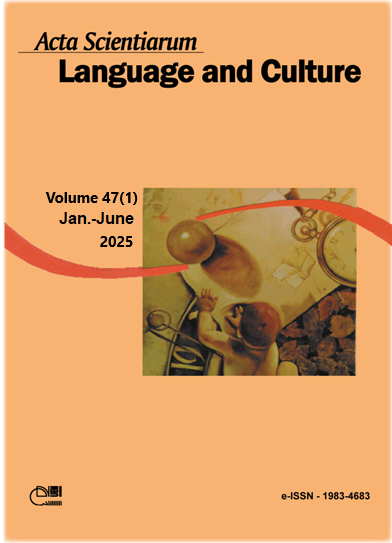Diachronic study of universal concessive-conditional clauses prefaced by quienquier(a) que in Peninsular Spanish
Abstract
This work presents a diachronic analysis of universal concessive-conditional constructions prefaced by quienquier(a) que in peninsular Spanish data, with the purpose of describing aspects of linguistic change. To do so, we start from the theoretical assumptions of Sweetser (1990), for whom the change in meanings can be explained through metaphorical connections that follow a unidirectional trajectory towards the expression of increasingly abstract, subjective, interpersonal meanings. Along with the evolution of meanings, we investigated the morphosyntactic changes that may have affected these structures. The corpus used, extracted from the CORDE database (Corpus Diacrónico del Español), brings together occurrences of concessive-conditional constructions in the ancient, middle and modern phases of Spanish. As analysis criteria, we chose the pragmatic domain of action (content, epistemic and speech act), factuality, mode-temporal coding and the ordering of the concessive-conditional structure. As a result, we attest that these structures specialized early in the expression of more abstract meanings, which was accompanied by changes in standards regarding factuality and the growing preference for anteposition.
Downloads
Metrics
References
Bybee, J. L. (2003). Mechanisms of change in grammaticization: the role of frequency. In B. D. Joseph, & R. D. Janda (Ed.), The handbook of historical linguistics (pp. 602-623). Blackwell.
Bosque, I. & Demonte, V. (Eds.), (1999). Gramática descriptiva de la lengua española. Espasa-Calpe.
Company Company, C., & Pozas Loyo, J. (2009). Los indefinidos compuestos y los pronombres genérico-impersonales omne y uno. In C. Company Company (Ed.), Sintaxis histórica de la lengua española (pp. 1075-1219). Fondo de Cultura Económica/Universidad Nacional Autónoma de México.
Eberenz, R. (1991). Castellano antiguo y español moderno: reflexiones sobre la periodización en la historia de la lengua. Revista de Filología Española, 71(1-2), 79-106. https://doi.org/10.3989/rfe.1991.v71.i1/2.652
Ford, C. E., & Thompson, S. A. (1986). Conditionals in discourse: A text-based study from English. In E. C. Traugott, A. Meulen, J. S. Reilly, & C. A. Ferguson (Ed.), On Conditionals (pp. 353-372). Cambridge University Press.
Flamenco García, L. (1999). Las construcciones concesivas y adversativas. In I. Bosque, & V. Demonte (Ed.), Gramática descriptiva de la lengua española (Vol. 3, pp. 3805-3878). Espasa-Calpe.
Haspelmath, M., & König, E. (1998). Concessive conditionals in the languages of Europe. In J. van der Auwera (Ed.). Adverbial construction in the languages of Europe (pp. 563-640). Mouton de Gruyter.
Heine, B. (2002). On the role of context in grammaticalization. In I. Wischer, & G. Diewald (Ed.), New reflections on grammaticalization (pp. 83-101). John Benjamins.
König, E. (1985a). On the history of concessive connectives in English, diachronic and synchronic evidence. Lingua, 66(1), 1-19. https://doi.org/10.1016/S0024-3841(85)90240-2
König, E. (1985b). Where do concessives come from? On the development of concessive connectives. In J. Fisiak (Ed.), Historical semantics. Historical word-formation (pp. 263-282). Mouton.
König, E. (1986). Conditionals, concessive conditionals and concessives: areas of contrast, overlap and neutralization. In E. C. Traugott, A. T. Meulen, J. S. Reilly, & C. A. Ferguson (Ed.), On conditionals (pp. 229-246). Cambridge University Press.
König, E. (1994). Concessive clauses. In R. E. Asher (Ed.), The encyclopedia of language and linguistics (pp. 679-681). Pergamon.
König, E., & Auwera, J. van der (1988). Clause integration in German and Dutch conditionals, concessive conditionals, and concessives. In J. Haiman, & S. A. Thompson (Ed.), Clause combining in grammar and discourse (pp. 101-134). John Benjamins.
Montolio Duran, E. (1999). Las construcciones condicionales. In I. D. Barreto, &. I. Bosque (Ed.), Gramática descriptiva de la lengua española (pp. 3643-3737). Espasa-Calpe.
Parazuelos, M. H. C. (1993a). La expresión de la concesividad en español [Tese de Doutorado, Universidad Complutense de Madrid].
Parazuelos, M. H. C. (1993b). “Inhibición” o “indiferencia”: Rasgo común a expresiones de sentido concesivo. Revista de Filología Románica, 10, 107-151. https://dx.doi.org/10.5209/RFRM
Pérez Quintero, M. J. (2002). Adverbial subordination in English: a functionalist approach. Rodopi.
Pérez Saldanya, M. (1999). El modo en las subordinadas relativas y adverbiales. In I. Bosque, & V. Demonte (Eds.), Gramática descriptiva de la lengua española (pp. 3253-3322). Espasa-Calpe.
Pérez Saldanya, M., & Salvador, V. (2009). Oraciones concesivas. In C. Company Company (Ed.), Sintaxis histórica de la lengua española. (pp. 3697-3840). Fondo de Cultura Económica/Universidad Nacional Autónoma de México.
Real Academia Española. (2009). Nueva Gramática de la Real Academia Española. Espasa-Calpe.
Rodríguez Rosique, S. (2008). Pragmática y gramática. Condicionales concesivas en Español. Peter Lang.
Sweetser, E. (1990). From etymology to pragmatics: metaphorical and cultural aspects of semantic structure. Cambridge University Press.
DECLARATION OF ORIGINALITY AND COPYRIGHTS
I Declare that current article is original and has not been submitted for publication, in part or in whole, to any other national or international journal.
The copyrights belong exclusively to the authors. Published content is licensed under Creative Commons Attribution 4.0 (CC BY 4.0) guidelines, which allows sharing (copy and distribution of the material in any medium or format) and adaptation (remix, transform, and build upon the material) for any purpose, even commercially, under the terms of attribution.
Read this link for further information on how to use CC BY 4.0 properly.




















6.png)









